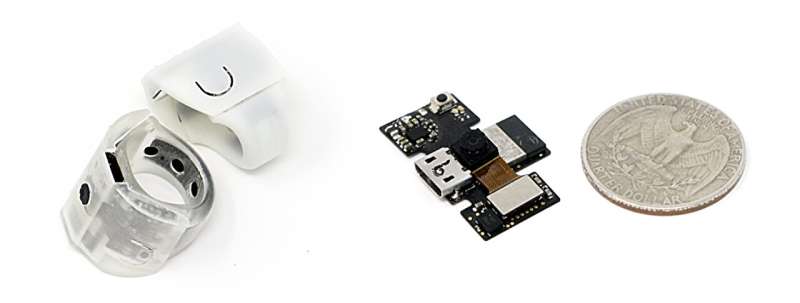While smart devices in homes have grown to include speakers, security systems, lights and thermostats, the ways to control them have remained relatively stable. Users can interact with a phone, or talk to the tech, but these are frequently less convenient than the simple switches they replace: “Turn on the lamp…. Not that one…. Turn up the speaker volume…. Not that loud!”
University of Washington researchers have developed IRIS, a smart ring that allows users to control smart devices by aiming the ring’s small camera at the device and clicking a built-in button. The prototype Bluetooth ring sends an image of the selected device to the user’s phone, which controls the device.
The user can adjust the device with the button and—for devices with gradient controls, such as a speaker’s volume—by rotating their hand. IRIS, or Interactive Ring for Interfacing with Smart home devices, operates off a charge for 16–24 hours.
The team presented its research at the 37th Annual ACM Symposium on User Interface Software and Technology in Pittsburgh. IRIS is not currently available to the public.
“Voice commands can often be really cumbersome,” said co-lead author Maruchi Kim, a UW doctoral student in the Paul G. Allen School of Computer Science & Engineering. “We wanted to create something that’s as simple and intuitive as clicking on an icon on your computer desktop.”
The team decided to put the system in a ring because they believed users would realistically wear that throughout the day. The challenge, then, was integrating a camera into a wireless smart ring with its size and power constraints. The system also had to toggle devices in under a second; otherwise, users tend to think it is not working.

UW researchers have developed IRIS, a smart ring that allows users to point and click to control smart devices. Here, the ring (left) is shown beside its circuit board and battery and a quarter. © Kim et al./UIST ’24
To achieve this, researchers had the ring compress the images before sending them to a phone. Rather than streaming images all the time, the ring gets activated when the user clicks the button, then turns off after 3 seconds of inactivity.
In a study with 23 participants, twice as many users preferred IRIS over a voice command system alone (in this case, Apple’s Siri). On average, IRIS controlled home devices more than two seconds faster than voice commands.
“In the future, integrating the IRIS camera system into a health-tracking smart ring would be a transformative step for smart rings,” Kim said. “It’d let smart rings actually augment or improve human capability, rather than just telling you your step count or heart rate.”
More information:
Maruchi Kim et al, IRIS: Wireless ring for vision-based smart home interaction, Proceedings of the 37th Annual ACM Symposium on User Interface Software and Technology (2024). DOI: 10.1145/3654777.3676327
Provided by
University of Washington
Citation:
A smart ring with a tiny camera lets users point and click to control home devices (2025, January 8)



